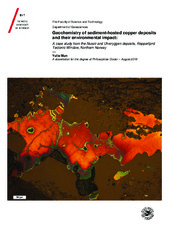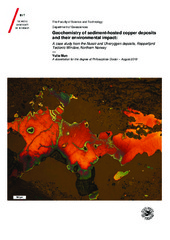| dc.contributor.advisor | Strmić Palinkaš, Sabina | |
| dc.contributor.author | Mun, Yulia | |
| dc.date.accessioned | 2019-11-13T14:23:51Z | |
| dc.date.available | 2019-11-13T14:23:51Z | |
| dc.date.issued | 2019-11-07 | |
| dc.description.abstract | Modern growing economy and technology require metals. Therefore mining is an unavoidable process. Mining in its turn results in the production of large amounts of mine waste. This research is focused on one type of mine waste, mine tailings, formed after the processing of Cu-sulphides deposits. Acid mine drainage (AMD) is a consequence of the oxidation of sulphide-rich rocks and has a drastic impact on the environment. In order to better understand the factors that can influence the rate of sulphides oxidation, a thorough investigation of primary ore and petrographic, mineralogical and geochemical characterization of host rocks was made on two sedimentary-hosted Cu deposits of Nussir and Ulveryggen in northern Norway. The exploitation of the Ulveryggen deposit in 1972-1978/79 resulted in mine tailings disposal in Repparfjorden. Mineralogical and geochemical investigation of marine sediments revealed that in spite of the fact that sulphides are generally well-preserved, some signs of AMD are present. To compare the submarine conditions of mine tailings disposal with on-land deposition, the Røros mining area, in Trøndelag, was chosen as a case study. Thermodynamical modeling was applied for determination of dissolved Cu speciation under the varying pH. The redox potential (Eh) is the major factor that influences the sulphides solubility while pH determines the dissolved species.
In anoxic submarine conditions, the sulphides remain well-preserved, while in oxic atmospheric conditions, the strong weathering occurs. Laboratory weathering tests were conducted during 90-days period to simulate the oxidation of sulphides in the submarine and on-land conditions. Carbonates and/or organic matter were added to marine sediments or quarzitic sand and infiltrated with seaweater or meteoric freshwater. The results demonstrated that organic matter prevents oxidation while carbonates trigger the Cu-sulphides weathering. | en_US |
| dc.description.doctoraltype | ph.d. | en_US |
| dc.description.popularabstract | Modern growing economy and technology require metals and therefore mining is an unavoidable process. Mining in its turn results in production of large amounts of mine waste. This research is focused on sulphide-rich mine tailings which is a slurry (mixture) of crushed rocks and water. The material is fine-grained which is dramatically increase the rate of oxidation due to the increase in surface area. In on-land, atmospheric conditions, the reaction of sulphide-rich rocks with a large amount of dissolved oxygen and Fe(III) species leads to the formation of very acidic waters, oxidation of rocks, and liberation of heavy metals that were in the lattice of sulphide minerals. This process is called acid mine drainage (AMD). Such an environmental problem often leads to devastation of local biota and reduction of water quality. These metals can also get to the aquifer and have negative impact of human health.
In 1972-1978/79 the sediment-hosted Cu deposit of Ulveryggen in northern Norway was in production and mine tailings were placed on the bottom of Repparfjorden. A part of this study was focused on a detailed investigation of mineralogical changes with sulphides. Overall, the observation revealed that sulphides are well-preserved with some exception that in the upper most horizon some chalcopyrite grains, CuFeS2, obtained an oxidized rim. This rim is not necessary formed in the submarine conditions and could be already existing at the stage of ore processing. In addition, Fe-Mn hydroxide hardpan was observed. The hardpan is often related to the AMD formation. The Nussir deposit of Cu is located in a vicinity of the Ulveryggen and its production is planned in the near future. To better predict the factors that can trigger the oxidation of tailing that will be produced, a thorough research on petrography, mineralogy, geochemistry has been done. In spite of the great vicinity of two deposits, the host rocks are different. Ulveryggen is composed predominantly by arkosic metasedimentary rocks while Nussir deposit is hosted by carbonate-rich lithologies. Silicates and carbonates have different buffering capacity to neutralize the acid.
To show the contrast, Røros mining area was chosen as an example of on-land disposal of mine waste. The presence of AMD is confirmed by field and microscopic observations. In addition, Røros is a volcanogenic-massive sulphides (VMS) deposit that is characterized by mafic volcanics as main host rocks and complex ore mineral assemblages. The more complex the ore is, the easier is to oxidized it due to galvanic effect. However, the most important triggering factor of ore oxidation is the amount of dissolved oxygen.
Thermodynamical modelling confirmed that redox potential controls the speed of sulphides oxidation, while pH is responsible in which species the metal, in case of this study Cu, will be mobilized. The results showed that in near-neutral-slightly alkaline conditions, the presence of carbonates will result in Cu mobilization and formation of CuCO3(aq) complexes. This fact should be taken into consideration while choosing the AMD remediation scenario. Laboratory-based weathering tests demonstrated that organic matter can significantly hinder the sulphides oxidation regardless the complexity of the ore and the type of hosting rocks. | en_US |
| dc.description.sponsorship | Troms Fylkeskommune, SINTEF, UiT | en_US |
| dc.identifier.isbn | 978-82-8236-367-9 | |
| dc.identifier.uri | https://hdl.handle.net/10037/16660 | |
| dc.language.iso | eng | en_US |
| dc.publisher | UiT Norges arktiske universitet | en_US |
| dc.publisher | UiT The Arctic University of Norway | en_US |
| dc.relation.haspart | <p>Paper 1: Mun, Y., Strmić Palinkaš, S., Kullerud, K., Nilsen, K.S., Neufeld, K. & Bekker, A. Evolution of metal-bearing fluids at the Nussir and Ulveryggen sediment-hosted Cu deposits, Repparfjord Tectonic Window, Northern Norway. (Submitted manuscript).
<p>Paper 2: Mun, Y., Strmić Palinkaš, S., Forwick, M., Junttila, J., Pedersen, K.B., Sternal, B., … Kullerud, K. Stability of Cu-sulphides in submarine tailing disposals: A case study from Repparfjorden, northern Norway. (Manuscript).
<p>Paper 3: Mun Y., Strmić Palinkaš S. & Kullerud K. The role of ore-forming processes and tailing disposal site conditions on a contrasting environmental impact of Cu-sulphide deposits in Norway. (Manuscript). | en_US |
| dc.rights.accessRights | openAccess | en_US |
| dc.rights.holder | Copyright 2019 The Author(s) | |
| dc.rights.uri | https://creativecommons.org/licenses/by-nc-sa/4.0 | en_US |
| dc.rights | Attribution-NonCommercial-ShareAlike 4.0 International (CC BY-NC-SA 4.0) | en_US |
| dc.subject | VDP::Technology: 500::Rock and petroleum disciplines: 510 | en_US |
| dc.subject | VDP::Teknologi: 500::Berg‑ og petroleumsfag: 510 | en_US |
| dc.title | Geochemistry of sediment-hosted copper deposits and their environmental impact: A case study from the Nussir and Ulveryggen deposits, Repparfjord Tectonic Window, Northern Norway | en_US |
| dc.type | Doctoral thesis | en_US |
| dc.type | Doktorgradsavhandling | en_US |


 English
English norsk
norsk

